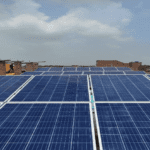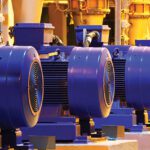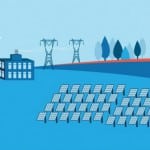Though our current power grid is more sophisticated and reliable than when Thomas Edison designed it nearly a century ago, it uses the same model: A company burns fuel to create electricity, which is then sent hundreds of miles along inefficient wires to customers who are given a single energy choice: on or off. Now, finally, that is changing, as our energy system becomes a two-way flow of both power and information in which customers both receive and produce electricity.
The U.S. will spend a projected $2 trillion in the next 20 years upgrading its power grid. We must make sure those investments are not spent on replacing old, dirty infrastructure with more of the same. The electricity systems we built in the last century, and the regulations that govern them, are no longer adequate to ensure reliability, fight climate change, or accommodate rapid changes in both technology and consumer demand. We need new rules, new ideas, and new approaches to overcome a century of the carbon-based “business as usual.”
New Rules
The landmark Clean Power Plan proposed in June by the federal Environmental Protection Agency is one crucial rule of the road that will help ensure that we stay on the fast track to a clean energy economy. Placing limits on power plant pollution is the single most important thing we can do right now to avoid irreversible climate change. From 2005 to 2013, the U.S. reduced its power sector carbon dioxide emissions by around 15%, thanks in large part to advances in energy efficiency and fuel switching from coal to natural gas. But to date, the power industry has had no limits on the amount of carbon pollution it can emit, even though power plants account for nearly 40% of U.S. carbon dioxide emissions from energy—more CO2 than all of our factories, homes, and businesses combined. These common-sense limits on carbon pollution from existing fossil fuel power plants deserve to be put in place straight away.
When adopted, these standards will be a landmark achievement for climate stability and public health; they could also go down in history for providing the tipping point in our nation’s transition to a clean energy economy. Retiring the most highly polluting coal-fired power plants presents a unique opportunity for clean energy solutions to fill this gap in generating capacity.
Real-world deployment of clean energy technologies is demonstrating that issues such as the variability of solar and wind energy can be addressed affordably, in ways that make the grid smarter, more efficient, and more reliable. Renewables are now the “fastest growing power generation sector,” with more solar panels installed in the U.S. over the last 18 months than the previous 30 years. The costs of solar and wind energy are falling rapidly, while electric vehicle sales are climbing, with 100%-electric U.S. car sales up nearly 450% in 2013. Energy efficiency, the “lowest-cost electricity resource” for utilities, can also significantly reduce energy use. A recent report from the American Council for an Energy-Efficient Economy showed that energy efficiency measures can slash carbon emissions from the U.S. power sector by 26% with no net cost to the economy.
Energy Sector Innovation
American companies are also playing an important role in our transition to clean energy by developing products and services that people want to buy. Products like Google’s Nest learning thermostat allow homeowners to control appliances remotely to help reduce peak load, while tools like demand response save money by putting consumers in the driver’s seat. Companies like SolarCity, with its groundbreaking solar leasing approach, and SCIenergy, with its innovative business model of providing energy efficiency as a service to commercial customers, are making cleaner energy affordable today.
These companies and others are transforming the way we make, move, and use energy. For example, in Austin’s Mueller neighborhood, a living consumer energy lab run by nonprofit Pecan Street Inc., some residents power their homes using little to no electricity from the grid over the course of the year, simply because they’ve installed home energy management systems and solar panels on the roofs of their houses.
This new reality requires a new business model—one that fairly values efficiency and clean, renewable energy. This means revising the current model, which measures success by the amount of megawatts sold, to one that rewards utilities for generating and selling energy more wisely, sustainably, and efficiently. After all, the cleanest and cheapest megawatt is the one utilities don’t have to generate.
Perhaps most importantly, public support for clean energy is at a record high. According to a 2013 poll by Yale University, 61% of Americans said developing sources of clean energy should be a high or very high priority for the president and Congress. People care about energy because it touches everything that we do, and Americans are tired of hearing sad, old myths about why we can’t move forward.
History and experience tell us that America can navigate this transition without threatening our non-negotiable commitment to safe, affordable, reliable energy. American ingenuity is second to none—and it will be supercharged when the U.S. pioneers an open, vibrant market for new, advanced energy that sparks private capital and technological innovation. My colleagues and I at Environmental Defense Fund look forward to working with our partners in the power industry to meet the challenges and enjoy the opportunities of this new era. ■
—Fred Krupp is president of Environmental Defense Fund.










